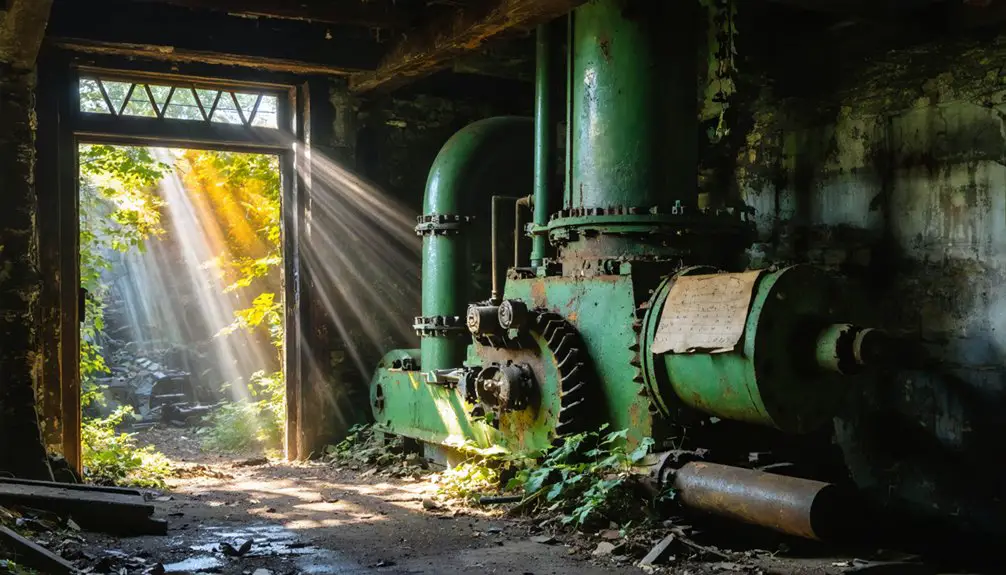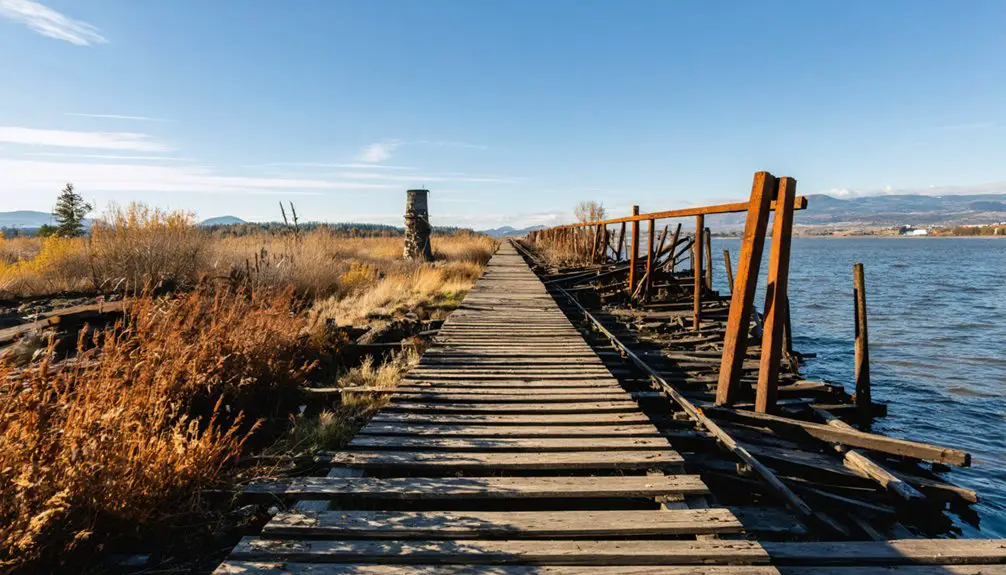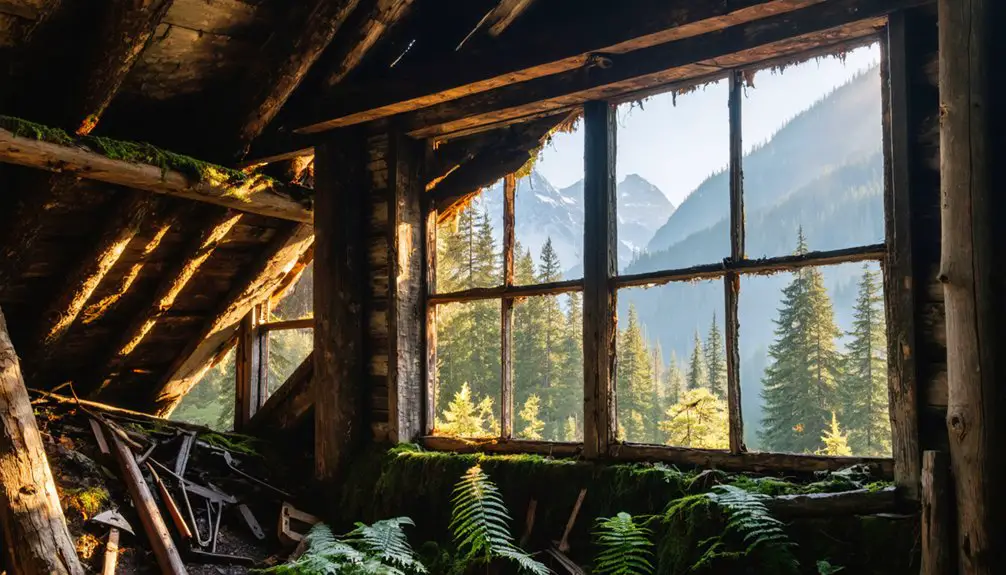You’ll discover the abandoned mining settlements of Copper City and Tull City deep in Washington’s Olympic Mountains, where copper was first discovered in 1902. These bustling camps, founded after Silas Marple’s mineral explorations, once supported up to 600 residents with sawmills, bunkhouses, and extensive mining operations. While only foundations and scattered mining equipment remain today, the historic Tubal Cain Mine site offers glimpses into Washington’s fascinating industrial heritage.
Key Takeaways
- Copper City emerged in 1902 after mineral discoveries in the Dungeness River area, featuring essential infrastructure like sawmills and bunkhouses.
- The mining community fluctuated between 200-600 residents, with families participating in labor and fostering strong social connections.
- Daily operations involved ore extraction worth $55 per ton, using old ore cars through tunnels and pack animals for transportation.
- The town included company stores, dining halls, and sawmills, creating a self-sustaining community in Washington’s challenging mountain terrain.
- Despite initial promise, the mining operations struggled with seasonal constraints, difficult terrain, and volatile metal prices.
The Birth of a Mining Dream in the Olympic Mountains
While the Olympic Mountains had long beckoned prospectors with promises of mineral riches, it wasn’t until 1902 that copper’s discovery in the Dungeness River drainage area sparked a serious mining rush.
You’ll find that the mining aspirations were first ignited by Silas Marple’s earlier explorations along the Big Quilcene River, where he identified promising mineral deposits in the late 1800s.
The geological insights from initial ore samples revealed a tantalizing mix of copper, gold, iron, and manganese, attracting enthusiastic investors to form ventures like the Tubal-Cain Copper & Manganese Mining Co.
Despite the challenging terrain that required pack animals to transport all mining supplies, these early prospectors established essential outposts including Copper City and Tull City, marking the beginning of an ambitious but ultimately ill-fated mining chapter. The treacherous supply routes stretched 25 miles upriver, requiring local packers to guide burro trains carrying equipment.
The operation’s fate was sealed when a devastating 1912 avalanche destroyed crucial infrastructure including the sawmill, powderhouse, and other essential buildings.
Life in Copper City and Tull City: A Tale of Two Camps
If you’d visited Copper City or Tull City in their prime, you’d have found bustling camps equipped with essential infrastructure including bunkhouses, sawmills, and processing facilities nestled in the harsh Olympic Mountain wilderness.
The 1906 construction of Copper City’s sawmill proved vital for building the camps’ structures, while surviving artifacts like metal boilers and Pelton wheels demonstrate the integration of industrial technology for mining operations and power generation. Miners relied on old ore cars to transport extracted materials through the extensive tunnel network.
Daily life centered around the demanding work of copper extraction, with miners supported by carefully planned facilities for storage, shelter, and ore processing within these remote mountain communities. The camp flourished under the leadership of Dan Sinclair, who incorporated Summit Mining Company in 1907 to oversee mineral production operations.
Daily Mining Camp Life
Two distinct mining camps, Copper City and Tull City, formed the backbone of Washington’s copper mining operations in the early 20th century.
You’d find miners living in basic wooden cabins and bunkhouses, sharing communal spaces to maximize efficiency and foster camp routines. The daily grind involved long hours of ore extraction, with assays sometimes reaching $55 per ton before shipping to Tacoma for processing. Many miners heated their meals on old cast-iron stoves found throughout the camps. The area contained 42 mining claims during its operational years.
Despite harsh conditions and isolation, miner camaraderie flourished through informal trading networks and community gatherings.
You’d have to be self-sufficient, as supplies were limited and medical care scarce. Natural hazards posed constant threats – the 1912 avalanche that destroyed Tubal Cain’s facilities served as a stark reminder of nature’s power and the precarious existence these determined miners faced.
Camp Infrastructure and Layout
Beyond the daily routines of mining life, the physical layout of Copper City and Tull City revealed thoughtful planning despite their remote locations. You’d find essential camp facilities strategically positioned, with bunkhouses and cookhouses clustered away from industrial zones to protect workers from mining hazards.
The camps’ spatial organization followed the natural topography, with roads and paths connecting critical structures while adapting to the mountainous terrain. The extensive infrastructure required 17-day man-camp rotations to maintain consistent operations throughout the mining seasons. The transportation system included a remarkable eleven-mile road with multiple switchbacks leading to the mining operations.
Resource management posed significant challenges, as both camps relied on nearby streams for water and on-site power generation. You’d notice the careful attention to sanitation issues, with outhouses placed at a distance from living quarters.
The camps also featured temporary structures and environmental adaptations, including prefabricated buildings during expansion phases and strategic placement of storage yards near loading points to optimize workflow.
Community and Social Dynamics
Despite their remote locations, Copper City and Tull City fostered vibrant social communities that reflected the era’s mining culture and economic realities. You’d have found tight-knit groups of miners and their families forging strong community bonds through shared experiences and collective survival strategies.
Like many Victorian-era structures, the buildings in these settlements served as gathering places that strengthened social ties.
The population, which fluctuated between a few hundred to 600 residents, gathered at communal spaces like company stores and dining halls to maintain social connections. When the mine closed in 1957 due to falling copper prices, it marked the end of an era for these close-knit mining communities.
Daily life revolved around the demands of mining work, with families often participating across generations in both labor and community activities.
While the population was mainly white settlers, these communities developed distinct social networks that helped them weather harsh conditions and economic uncertainties.
Religious gatherings and educational activities strengthened these connections, creating lasting social frameworks that defined life in these mining settlements.
The Rise and Fall of Tubal Cain Mine
When copper was discovered in Washington’s Dungeness River drainage area in 1902, the Tubal-Cain Copper & Manganese Mining Co. quickly established operations and built access trails to exploit the promising ore deposits.
You’ll find that mining heritage shaped two early camps – Copper City and Tull City – where crews battled challenging terrain to transport equipment via burros.
Despite initial enthusiasm around copper extraction, the venture faced devastating setbacks. A 1912 avalanche destroyed critical infrastructure, including the sawmill and powderhouse.
The mine’s profitability suffered from scattered, low-grade ore bodies, fragmented by mountain upheaval. Though Olympic Manganese Co. attempted revival from 1935 to 1941, the mine never achieved commercial success.
Today, only metal remnants and cabin foundations remain within the Buckhorn Wilderness, evidence of this ambitious but ill-fated enterprise.
Mining Infrastructure and Technology in the Wilderness
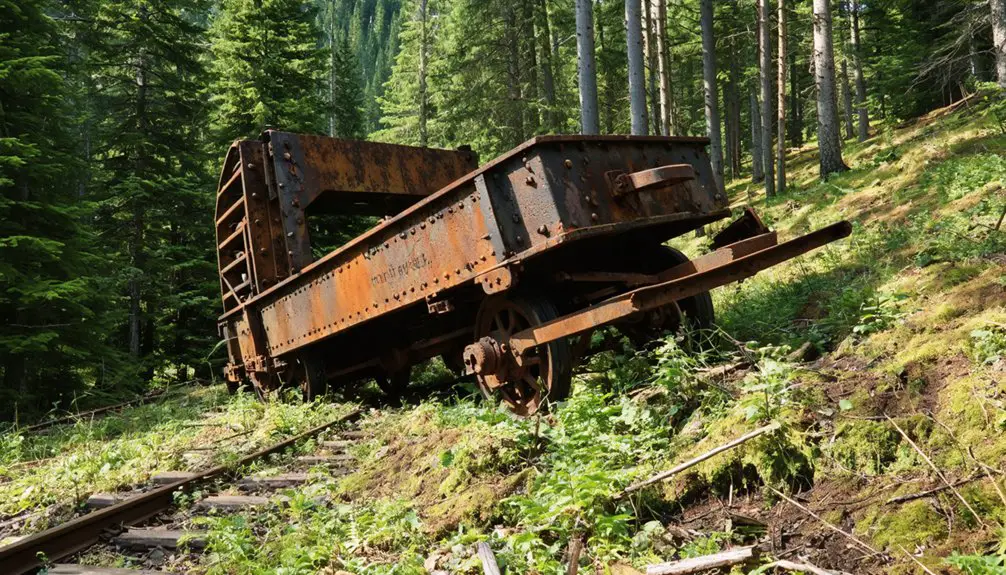
As Washington’s remote copper mines expanded into challenging wilderness terrain, mining companies faced complex logistical hurdles in establishing essential infrastructure and technology systems.
You’ll find that transportation challenges defined these operations, with locations like Holden Mine accessible only by ferry or rugged trails, while ore processing required sophisticated facilities capable of handling thousands of tons daily.
- Mining towns needed complete infrastructure including dormitories, hospitals, and schools
- Underground operations utilized narrow-gauge rails and ore carts for extraction
- Seasonal constraints limited active mining to just 4 months in some locations
- Ore transportation often involved complex multi-stage journeys to distant smelters
- Remote locations required careful management of water, power, and waste systems
These wilderness operations showcased remarkable engineering achievements despite their isolation and environmental challenges.
Economic Challenges and the Elusive Ore Veins
While Washington’s copper mines held promising mineral deposits, they struggled with persistent economic instability driven by volatile metal prices and steep operational costs.
You’ll find that historic ventures like the Lone Star Project faced numerous exploration hurdles, producing limited tonnage during both its underground (146,540 tonnes) and open-pit (400,000 tonnes) phases.
Remote locations demanded costly ore transport, often requiring 11-kilometer hauls to processing facilities.
Today’s mining prospects still grapple with elusive ore veins and complex geology that modern technology hasn’t fully mapped.
The deposits remain “open to the east and south,” suggesting untapped potential.
Yet regulatory constraints, environmental considerations, and fierce global competition – particularly from state-backed enterprises – continue to challenge the economic viability of Washington’s copper resources.
Natural Disasters and the Mine’s Demise
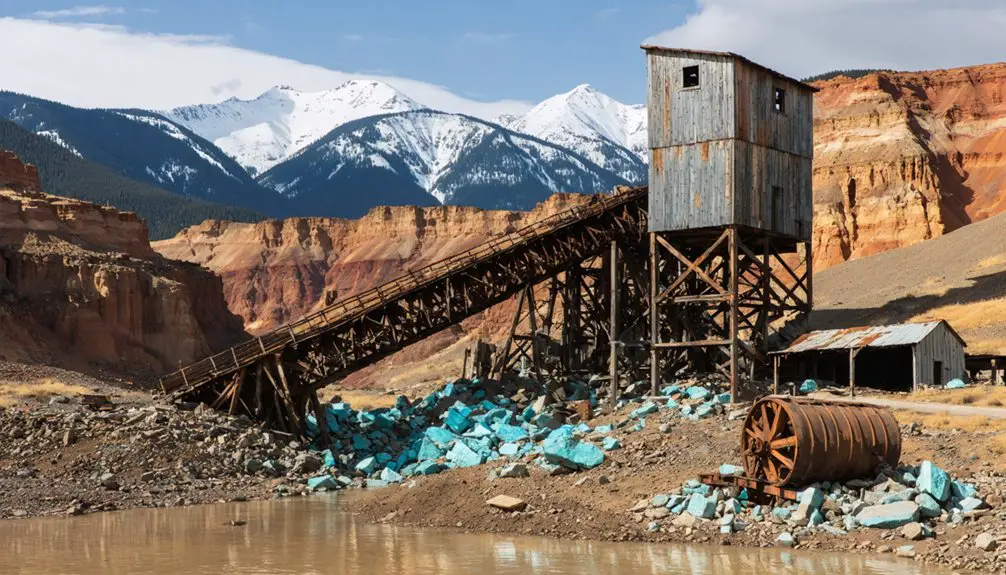
Despite promising mineral deposits, Washington’s copper mines succumbed to a series of devastating natural disasters that ultimately sealed their fate.
You’ll find that these mine safety challenges created insurmountable obstacles for the region’s mining operations:
- Landslides and floods ravaged Eastern Washington’s mining districts, blocking essential drainage systems and damaging critical infrastructure.
- Flood-induced tailings dam failures threatened local ecosystems, particularly the Similkameen River system.
- Heavy rains and snowmelt regularly inundated mine shafts, forcing costly shutdowns and evacuations.
- Natural disasters disrupted access roads and culverts, severely limiting operational capabilities.
- Contaminated water supplies from disaster-related mine waste created regulatory compliance issues.
These environmental challenges, combined with the proposed 260-meter tailings dam expansion, raised serious concerns about long-term viability and ultimately contributed to the copper town’s abandonment.
Legacy of the Biblical Metalsmith’s Namesake
You’ll find a profound symbolic connection between the Tubal Cain Mine and its biblical namesake, who appears in Genesis 4:22 as humanity’s first metalsmith and craftsman.
The mine’s founders drew upon this ancient spiritual legacy when naming their copper operation, linking Washington’s early industrial aspirations to sacred metallurgical traditions.
This biblical association reflects how faith and mining culture intertwined in early 20th century America, as prospectors and mining companies often incorporated religious symbolism into their ventures.
Biblical Mining Symbolism Endures
Throughout biblical texts, copper and its alloys carry profound symbolic weight, representing strength, endurance, and divine judgment. You’ll find this copper symbolism woven deeply into sacred narratives, from Solomon’s temple to ancient mining sites like Timna Valley.
- Copper’s presence in temple construction reflected divine provision and sacred purpose.
- Mining legacy at sites like Punon and Timna Valley validates biblical accounts.
- Sacred metalwork, exemplified by Hiram of Tyre, merged spiritual calling with technical mastery.
- Archaeological evidence confirms advanced metallurgical knowledge in biblical times.
- Copper’s dual role as both practical material and spiritual symbol endures through history.
This rich symbolism reminds us that mining wasn’t merely extractive – it represented humanity’s partnership with divine provision, transforming raw materials into vessels of sacred significance.
Faith Shapes Mining Culture
When biblical metallurgy met Washington’s mining frontier, it found enduring expression in the Tubal Cain Mine, named for Genesis 4:22’s legendary metalsmith.
You’ll find this spiritual legacy woven throughout mining communities, where faith traditions fostered resilience during physically demanding and economically uncertain times.
In places like Holden Village, mining culture embraced the sacred metalsmith archetype, portraying miners as modern artisans in a divine-human partnership.
This spiritual framework helped you interpret both triumphs and setbacks while building communal solidarity.
Churches and gatherings reinforced moral values, offering daily refuge beyond mere economic pursuits.
The biblical metalsmith symbolism elevated mining work into a sacred craft, inspiring pride and perseverance despite the occupation’s challenges.
Through this lens, you’d understand mining as more than labor – it became a spiritual calling.
Preserving the Remnants: A Historical Journey
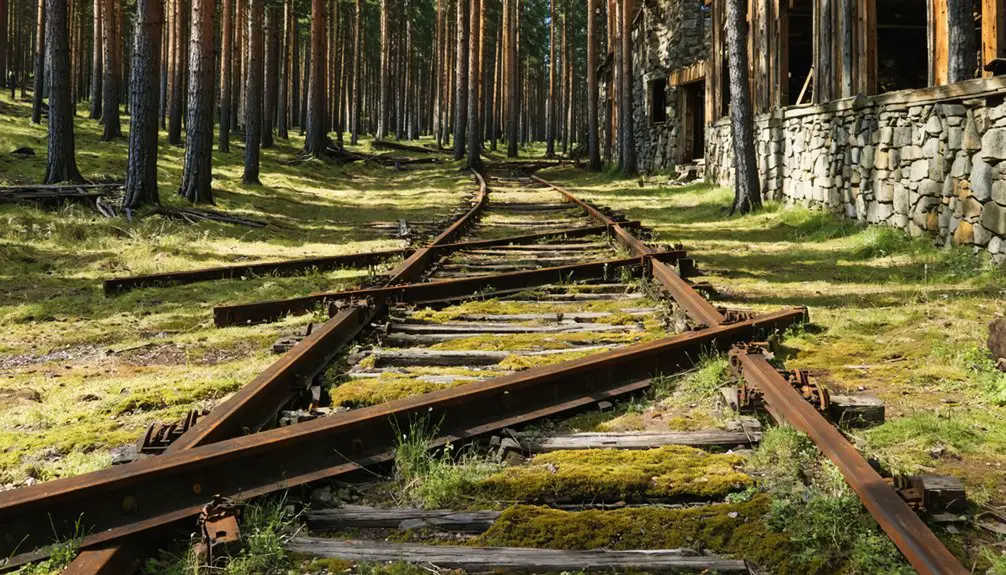
Hidden within the Buckhorn Wilderness, the physical remnants of Washington’s once-ambitious Tubal Cain Mine tell a compelling story of industrial perseverance and ultimate defeat.
As you explore this cultural heritage site, you’ll discover traces of a forgotten era in industrial history, where dreams of copper wealth collided with nature’s harsh realities.
- Metal boilers and a Pelton wheel stand as silent witnesses to early 20th-century mining technology
- The main adit tunnel extends 450 meters into Mount Worthington, marking human determination
- Two mining camps, Copper City and Tull City, left scattered foundations that hint at daily life
- Wire remnants and mining equipment showcase the scale of operations
- The encroaching forest continues to reclaim these historic structures, creating an urgent need for preservation
Modern Adventures in Washington’s Mining Past
Today’s adventurers seeking Washington’s mining heritage can explore a wealth of historic copper sites, though under vastly different conditions than their industrial predecessors.
You’ll find opportunities for recreational exploration throughout the North Cascades, where both patented and unpatented claims still exist. While modern technology aids in evaluating these historic districts, you’ll need to navigate carefully within environmental regulations and land preservation rules.
Many sites offer unique combinations of outdoor adventure and historical discovery, particularly in remote mountain regions. You can follow authorized trails along former mining roads, photograph preserved infrastructure, and study geological formations.
Trek historic mining paths in Washington’s mountains to uncover remnants of industry while exploring rugged wilderness landscapes.
However, you must remain mindful of safety concerns at abandoned mines, including unstable workings and contaminated runoff. The experience connects you directly to Washington’s industrial past while respecting current conservation priorities.
Frequently Asked Questions
What Indigenous Tribes Originally Inhabited the Land Around Tubal Cain Mine?
You’ll find the S’Klallam peoples, including Jamestown and Port Gamble bands, were primary inhabitants of this area, with their indigenous history and tribal culture extending throughout the Dungeness River drainage region.
How Many Miners Lost Their Lives During Tubal Cain’s Operational Years?
While you might imagine dangerous conditions in early mining operations, there’s no documented evidence of miner fatalities at Tubal Cain during its 1902-1920s run, despite limited safety regulations of that era.
What Happened to the Mining Equipment After the Mine Was Abandoned?
You’ll find most mining equipment from Tubal Cain became an abandoned legacy, with parts likely salvaged for scrap while other machinery was left to deteriorate in the remote wilderness location.
Were There Any Competing Copper Mines Nearby During Tubal Cain’s Operation?
You’ll find several competing mines operated near Tubal Cain, with historical rivalries centered in the Iron Mountain district, Quilcene area, and Tull City, though none proved profitable like Tubal Cain.
Did Any Former Miners’ Descendants Still Live in the Area Today?
You’ll find limited evidence of mining heritage being preserved through direct family connections today, as most descendants relocated after mine closures, though some may visit Holden Village periodically.
References
- https://en.wikipedia.org/wiki/Tubal_Cain_mine
- https://www.dnr.wa.gov/Publications/ger_ic74_min_industry_wa_devel.pdf
- https://www.holdenvillage.org/about/history/
- https://www.youtube.com/watch?v=0VS2bJhS2pw
- https://www.youtube.com/watch?v=hObKo3WOiHg
- https://www.kawal.net/tubalcain.htm
- https://edgeeffects.net/born-with-a-copper-spoon/
- https://www.nps.gov/parkhistory/online_books/olym/hrs/chap3.htm
- https://dnr.wa.gov/washington-geological-survey/explore-popular-geology/geologic-provinces-washington/olympic-mountains
- https://www.youtube.com/watch?v=9SaHbSkLK-A
